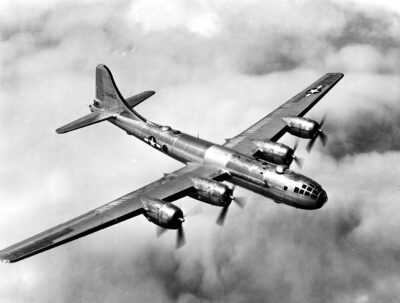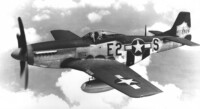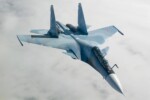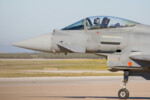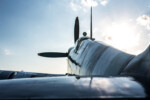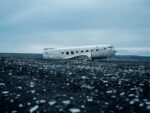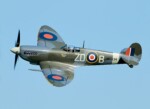B-17, B-29, and 8 Other Great American Bombers of WW2
10 December 2021 | Updated on February 05, 2024
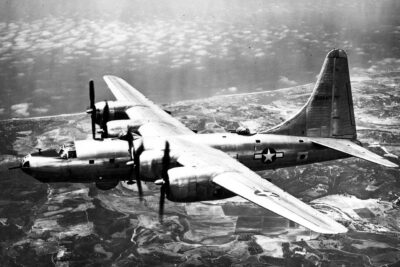

American WW2 bombers flown by the United States Air Force and allied pilots played a significant role in destroying enemy defenses, devastating their war production capability, and helping hasten the end of the war (together with American fighter planes of WW2). Their ability to unleash torrents of bombs on unsuspecting towns and cities deep inside enemy territory brought the horrors of war to people who lived far away from the battle frontlines.
Pre-war bombers were mostly unreliable and underpowered aircraft that only highly skilled pilots could safely operate. However, by the end of the war, wartime innovations in aviation technology like pressurized cabins and supercharged turbo engines for high-altitude bombers helped usher in a new age of flight during peacetime. These and several other technologies migrated into civilian aircraft, making commercial transatlantic flight possible.
10 Great American Bombers of WW2
We have compiled a list of the 10 great American bombers of WW2. It is a roll call of the largest, heaviest, toughest, most famous, most complicated, and the deadliest bombers in WWII.
10. Consolidated B-24 Liberator


U.S. Air Force archived photograph
The Consolidated B-24 Liberator is one of America’s most prolific heavy bombers of WWII and the backbone of allied strategic bombing missions before the introduction of B-17 and B-29 WW2 bombers. B-24s served in every WWII theater of war, including the Mid-Atlantic Anti-submarine campaign. Consolidated Aircraft engineers designed the B-24 as a long-range, fast cruiser with a high payload capacity. The B-24 could carry a similar payload amount as the bigger B-17 Flying Fortress in its two central cargo bays, thanks to a slab-sided fuselage design.
Unlike other bombers in WW2, the B-24 Liberator could claim responsibility for the most decisive Allied victory during anti-submarine missions in the Mid-Atlantic. Royal Air Force VLR B-24s equipped with ASV Mark II radar and PB4Y naval variants sank more than 93 German U-boats. Thus reducing allied shipping losses and eventually turning the tide of the war in their favor.
Fun Fact: The B-24 Liberator currently holds the world record as the most-produced American military aircraft of all time.
Aircraft details
- Manufacturer – Consolidated Aircraft
- Max Speed – 297 mph (478 kph)
- Introduction – 1941
- Role – Heavy bomber, Anti-submarine warfare
- Engine – 4 x Pratt & Whitney R-1830-35 Twin Wasp, R-1830-41 or R-1830-65 14-cylinder turbosupercharged radial piston engines, 1,200 hp (890 kW) each
- Crew – 11
- Service Ceiling – 28,000 ft (8,500 m)
- Range – 1,540 mi (2,480 km, 1,340 nmi)
- No Built – 18,188
- Retired – 1968
9. Douglas DB-7/A-20 Havoc


USAAF – Official U.S. Air Force photo
The Douglas DB-7 is a medium bomber and one of the few WW2 bombers with variants designed to perform multi-role missions. This versatile aircraft was operated by the United States and Allied forces and saw combat mainly on the Russian front and in North Africa. Although, the internal company designation is DB-7. The aircraft attack and night intruder variants were called A-20 Havoc, while the bomber was code-named Boston. During testing, pilots described the DB-7 as highly maneuverable and easy to fly. Ex-pilots rate the aircraft among the most favorite bombers of WWII.
Additionally, the DB-7 has the dubious distinction of being among a handful of WW2 bombers deployed against allied and axis forces. French operated DB-7s were involved in the Armée de l’Air defense against the German invasion in May 1940. Captured DB-7s under the control of the French Vichy government bombed Allied positions during the Allied incursion of French North Africa.
Fun Fact: The Soviet Union was the largest operator of the Douglas DB-7 during World War II, despite the aircraft being American developed and built.
Aircraft details
- Manufacturer – Douglas Aircraft Company
- Max Speed – 317 mph (510 kph)
- Introduction – 1941
- Role – Medium bomber
- Engine – 2 × Wright R-2600-23 Twin Cyclone 14-cylinder radial piston engines, 1,600 hp (1,200 kW) each
- Crew – 3
- Service Ceiling – 23,700 ft (7,200 m)
- Range – 945 mi (1,521 km, 821 nmi)
- No Built – 7,478
- Retired – 1949
8. Douglas A-26 Invader
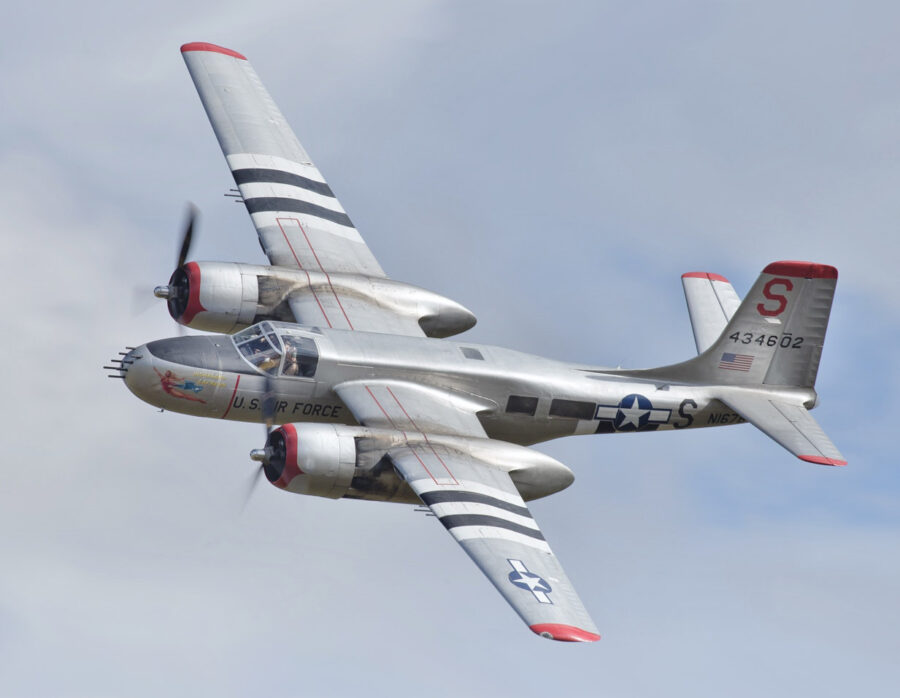

Photo by Ragnhild & Neil Crawford
Designed as a successor to one of the most popular bombers in WW2, the DB-7/A-20 Havoc. Douglas Aircraft engineered the A-26 Invader to be a light bomber capable of ground attack missions. The cutting-edge NACA 65-215 laminar flow airfoil wing design of the A-26 was invented by aerodynamicists for excellent performance and handling.
World War aircraft enthusiasts often confuse the A-26 Invader with the Martin B-26 Marauder, one of the great bombers of WWII. Although both WW2 bombers share the same Pratt & Whitney engine, they have entirely different fuselage design, flight, and handling characteristics. The Douglas A-26 Invader was active in the Pacific and European theaters of WWII, where the aircraft excelled at bombing missions.
Fun Fact: The A-26B attack bomber variant was equipped with dual-cockpit flight controls, and either side could be deactivated to allow the gunner to access the nose section.
Aircraft details
- Manufacturer – Douglas Aircraft Company
- Max Speed – 359 mph (578 kph)
- Introduction – 1942
- Role – Light bomber
- Engine – 2 x Pratt & Whitney R-2800-71 Double Wasp/ -27s, or -79s 18-cylinder two-row radial piston engines, 2,000 hp (1,500 kW) each
- Crew – 3
- Service Ceiling – 28,500 ft (8,700 m)
- Range – 1,600 mi (2,600 km, 1,400 nmi)
- No Built – 2,503
- Retired – 1980
7. Martin B-26 Marauder
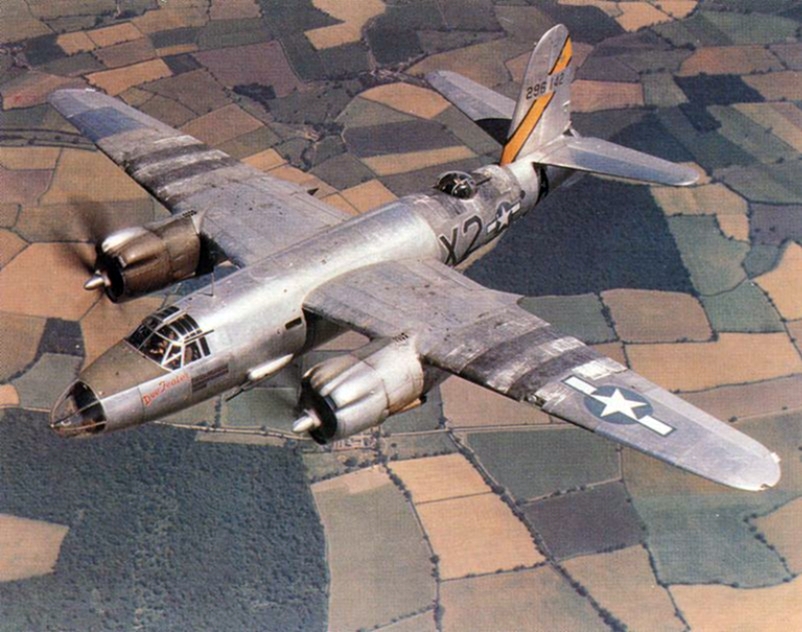

Glenn L. Martin aircraft company made a massive impact in the second war with its Martin B-26 Marauder considered by many as one of the great bombers of WWII. It is among the most widely deployed WW2 bombers with extensive operations in Western Europe, the Pacific, and the Mediterranean theatre. The B-26 has the highest wing loading (53 lb/sq ft (260 kg/m2) compared to other bombers in WWII or any aircraft in military service until the production of the Boeing B-29 Superfortress.
Inexperienced pilots had difficulty flying the plane due to the high-speed landing and take-off (150 mph/241 kph on final runway approach). And despite the aircraft’s reputation as a widow maker, the B-26 Marauder has the lowest loss rate at the end of the war compared to other bombers in WW2. The Douglas A-26 Invader was assigned the Marauder’s B-26 designation after its retirement in 1947, resulting in the common misidentification of the two unrelated WW2 bombers.
Fun Fact: Due to widespread pilot complaints about the B-26 shortcomings in the press. Martin and the United States Army Air Corps commissioned several newspaper and magazine articles defending the aircraft safety record. Additionally, the U.S Army Air Corps trained several Women Airforce Service Pilots to fly the Marauder in-flight demonstrations around the United States to shame the male pilots.
Aircraft details
- Manufacturer – Glenn L. Martin Company
- Max Speed – 287 mph (462 kph)
- Introduction – 1941
- Role – Medium bomber
- Engine – 2 × Pratt & Whitney R-2800-43 Double Wasp 18-cylinder radial piston engines, 2,000–2,200 hp (1,500–1,600 kW) each
- Crew – 7
- Service Ceiling – 21,000 ft (6,400 m)
- Range – 1,150 mi (1,850 km, 1,000 nmi)
- No Built – 5,288
- Retired – 1947
6. Boeing B-17 Flying Fortress
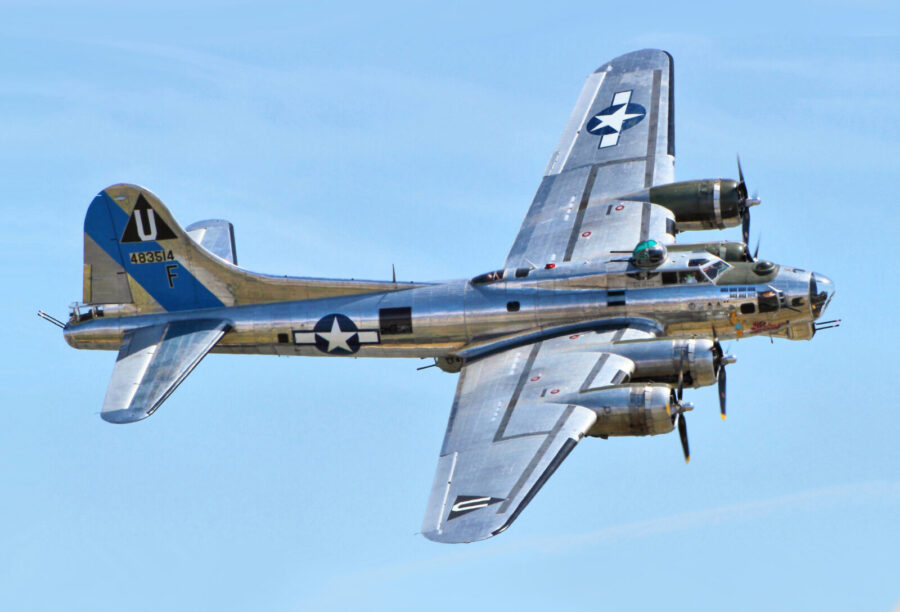

Photo by Wikipedia user Airwolfhound
Boeing’s B-17 Flying Fortress is a long-range, heavy bomber developed to perform strategic bombing missions at Axis industrial, civilian, and military targets. It has one of the largest bomb payloads compared to WW2 bombers of similar size. The Flying Fortress was beloved by its flight crews for its durability, and numerous pilots and aircrews have recounted stories of their badly damaged Flying Fortresses making the trip back to base.
The B-17 dropped more bombs during sorties over German territory than other bombers in WW2. It is one of the produced bombers of WWII after the B-24 Liberator and Junkers Ju 88. B-17 squadrons in England, Italy, and North Africa played a prominent role in destroying vital German wartime industrial facilities and military installations, including U-boat pens, ammunition dumps, and docks, in preparation for the D-Day invasion of France.
Fun Fact: The name “Flying Fortress” was first used by a newspaper journalist who thought that the numerous machine guns sticking out of the large bomber made it resemble a “15-ton flying fortress.”
Aircraft details
- Manufacturer – Boeing
- Max Speed – 287 mph (462 kph)
- Introduction – 1938
- Role – Heavy strategic bomber
- Engine – 4 × Wright R-1820-97 “Cyclone” turbosupercharged radial engines, 1,200 hp (895 kW) each
- Crew – 10
- Service Ceiling – 35,600 ft (10,850 m)
- Range – 2,000 mi (3,219 km, 1,738 nmi)
- No Built – 12,731
- Retired – 1968
5. Consolidated B-32 Dominator
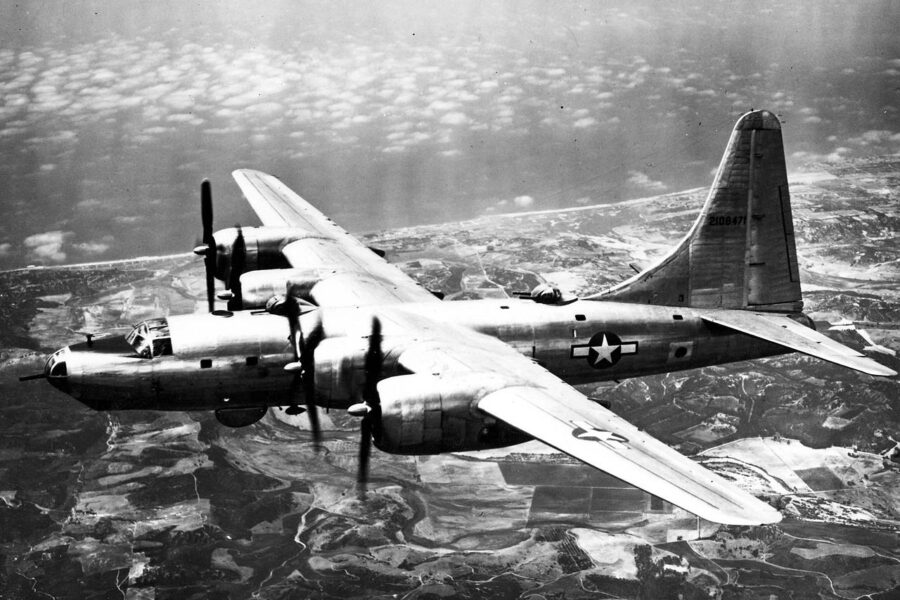

The Consolidated B-32 Dominator is one of the biggest bombers in WW2, but problems repeatedly plagued it during development. Thus, the bomber was deployed near the end of World War II, and it had minimal impact on the war outcome compared to other WW2 bombers.
Fearing problems with the B-29 Superfortress, which was under development, the United States Army Air Corps (USAAC) ordered the Consolidated Aircraft Company to develop the B-34 as a backup heavy strategic bomber. Eventually, the massive success of the Boeing Superfortress led the USAAC to cut their orders for the B-32 Dominator.
Fun Fact: The Consolidated B-32 Dominator holds the record of being the last Allied aircraft to engage in combat in WW2.
Aircraft details
- Manufacturer – Consolidated Aircraft
- Max Speed – 357 mph (575 kph)
- Introduction – 1945
- Role – Heavy strategic bomber
- Engine – 4 × Wright R-3350-23A Duplex-Cyclone 18-cylinder radial piston engines, 2,200 hp (1,600 kW) each
- Crew – 10
- Service Ceiling – 30,700 ft (9,400 m)
- Range – 3,800 mi (6,100 km, 3,300 nmi)
- No Built – 118
- Retired – 1945
4. North American B-25 Mitchell
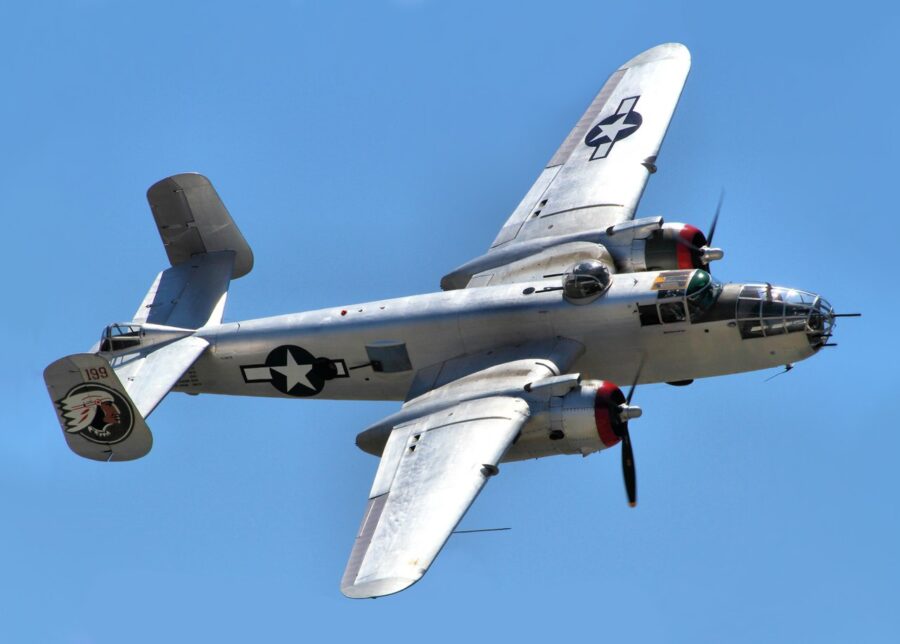

Photo by Wikipedia user Airwolfhound
The B-25 Michell is one of the most popular medium bombers of WWII, produced by the North Aviation Company. The aircraft was instrumental to allied forces’ victories in almost every battle, campaign, and operation in all theaters of conflict during World War II. Perhaps the most prominent achievement of the B-25 was the Doolittle Raid, where a squadron of B-25s attacked the Japanese mainland a few months after the Pearl Harbor bombing.
The B-25 Michell had significant combat roles than other WW2 bombers in North Africa, the Mediterranean, and Europe. It performed support roles for allied ground actions at the Second Battle of El Alamein in Egypt, Sicily’s invasion, and the allies’ subsequent advance into occupied central Europe by bombing roads and rail lines. B-25 gunships (B-25G) were effective anti-shipping weapons credited with destroying numerous enemy ships.
Fun Fact: The North American B-25 Mitchell was named in honor of General William “Billy” Mitchell, a pioneer of U.S. military aviation.
Aircraft details
- Manufacturer – North American Aviation
- Max Speed – 272 mph (438 kph)
- Introduction – 1941
- Role – Medium bomber
- Engine – 2 × Wright R-2600-92 Twin Cyclone 14-cylinder two-row radial piston engines, 1,700 hp (1,300 kW) each
- Crew – 5
- Service Ceiling – 24,200 ft (7,400 m)
- Range – 1,350 mi (2,170 km, 1,170 nmi)
- No Built – 9,816
- Retired – 1979
3. Curtiss SB2C Helldiver/A-25 Shrike
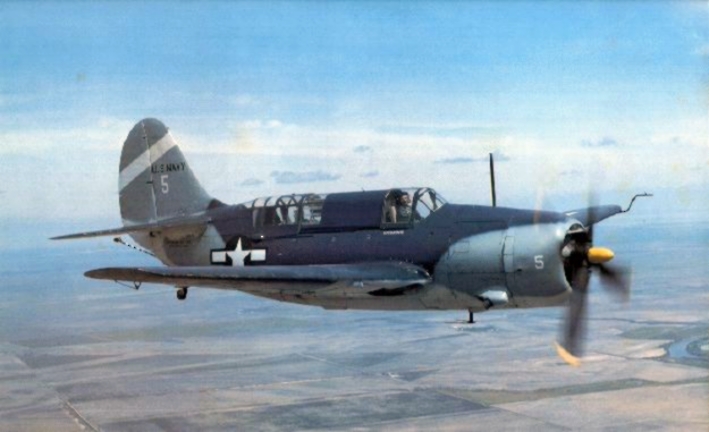

The Curtiss SB2C was among the purpose-built dive bombers in WWII developed to deliver bombs with greater accuracy against specific targets. Built to replace the Douglas SBD Dauntless, the SB2C featured numerous technical innovations, including internal bomb bays which reduced drag when loaded with bombs. However, the Helldiver suffered from numerous post-production technical issues due to the demanding multi-role performance requirements imposed on Curtiss Wright by the United States armed forces.
Production SB2Cs are among the few WW2 bombers designed for both carrier (SB2C-1 naval variant) and land-based (SB2C-1A) operations. SB2Cs operated by the United States and the Australian Air Force saw action mainly in Asia against the Japanese.
Fun Fact: Common nicknames for the SB2C Helldiver or A-25 Shrike include “Big-Tailed Beast,” “Two-Cee,” or simply “Beast.”
Aircraft details
- Manufacturer – Curtiss Wright
- Max Speed – 295 mph (475 kph)
- Introduction – 1942
- Role – Dive bomber
- Engine – Wright R-2600-20 Twin Cyclone 14-cylinder air-cooled radial piston engine, 1,900 hp (1,400 kW)
- Crew – 2
- Service Ceiling – 29,100 ft (8,900 m)
- No Built – 7,140
- Retired – 1959
2. Douglas SBD Dauntless/A-24 Banshee


U.S. Navy photo
Arguably one of the most significant bombers of WWII, the Douglas SBD Dauntless was the mainstay of the United States Navy carrier-based bombing operations between 1940 and 1944. Just like its successor, the Curtiss SB2C Helldiver/A-25 Shrike. SBDs were among the few famous bombers in WW2, flown by the United States Navy and the Marine Corps (A-24 Banshee) from aircraft carriers and land bases in the Pacific, North Africa, and Europe.
The Dauntless sank more enemy ships than other allied WW2 bombers in the Pacific Theater of the war, and it is credited with securing the allied victory during the Battle of Midway in 1942. During the battle, four Naval SBD dive-bomber squadrons destroyed three Japanese aircraft carriers within three minutes ((Akagi, Kaga, and Sōryū the Hiryū was destroyed later in the day) sank one Japanese heavy cruiser while damaging another in the process.
Fun fact: Douglas SBD Dauntless aircrews derived the aircraft’s nickname “Slow But Deadly” from its SBD initials.
Aircraft details
- Manufacturer – Douglas Aircraft
- Max Speed – 255 mph (410 kph)
- Introduction – 1940
- Role – Dive bomber
- Engine – Single Wright R-1820-60 Cyclone 9-cylinder air-cooled radial piston engine, 1,200 hp (890 kW)
- Crew – 2
- Service Ceiling – 25,530 ft (7,780 m)
- Range – 1,115 mi (1,794 km, 969 nmi)
- No Built – 5,936
- Retired – 1959
1. Boeing B-29 Superfortress
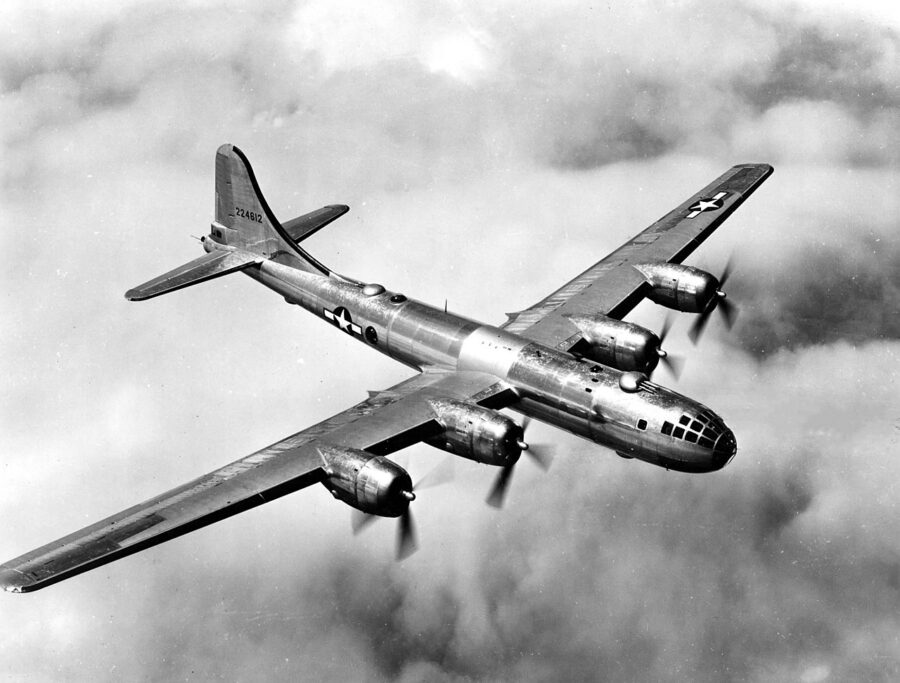

defense.gov photo
The Boeing B-29 Superfortress is the only aircraft in history to deploy a weapon of mass destruction in actual combat. Also, it is the only aircraft to drop nuclear bombs in a war. B-29s are the most famous bombers of WWII due to dropping atomic bombs on Hiroshima and Nagasaki. Developed as a larger, high altitude, and longer range replacement aircraft for the B-17, B-29 Superfortresses could carry a bigger bomb payload and fly on non-stop bombing raids from their bases in Asia and the Pacific to Japan and return. The aircraft is so big that it requires purpose-built airfields with enough parking and support operations, including long runways for take-off and landings.
The Boeing B-29 was one of the most advanced bombers in WW2, and it was equipped with cutting-edge technology unavailable on other large WW2 bombers. With development and production costs of $3 billion ($43 billion today), the Superfortress was more expensive than other WW2 bombers. And it spawned a generation of Boeing military aircraft and commercial airliners. B-29s carried the most destructive air-raid in recorded history over Japanese territory. And they were responsible for devastating Japanese war manufacturing, eventually eliminating Japan’s ability to defend itself successfully.
Fun Fact: In 1949, a re-engined Boeing B-29 Superfortress named “ Lucky Lady II” holds the record for being the first aircraft to fly non-stop around the globe during a 94-hour flight.
Aircraft details
- Manufacturer – Boeing
- Max Speed – 357 mph (575 kph)
- Introduction – 1944
- Role – Strategic heavy bomber
- Engine – 4 x Wright R-3350-23 Duplex-Cyclone 18-cylinder turbosupercharged radial piston engines, 2,200 hp (1,600 kW) each
- Crew – 11
- Service Ceiling – 31,850 ft (9,710 m)
- Range – 3,250 mi (5,230 km, 2,820 nmi)
- No Built – 3,970
- Retired – 1960




















